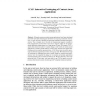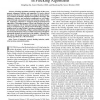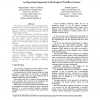1053 search results - page 181 / 211 » The Rules of Virtual Groups |
80
Voted
PR
2008
14 years 11 months ago
2008
In handwritten pattern recognition, the multiple classifier system has been shown to be useful for improving recognition rates. One of the most important tasks in optimizing a mul...
111
click to vote
PERVASIVE
2006
Springer
14 years 11 months ago
2006
Springer
Although numerous context-aware applications have been developed and there have been technological advances for acquiring contextual information, it is still difficult to develop a...
89
Voted
TFS
2008
14 years 10 months ago
2008
Abstract--Flocking algorithms essentially consist of three components: alignment, cohesion, and separation. To track a desired trajectory, the flock center should move along the de...
88
Voted
INFSOF
2000
14 years 10 months ago
2000
We construct models as an aid to our thought process. A particular class of models, operational models, can be used for simulation and prototyping. The Opj modeling language is su...
101
click to vote
KBS
2002
14 years 10 months ago
2002
Multilevel Flow Models (MFM) are graphical models of goals and functions of technical systems. MFM was invented by Morten Lind at the Technical University of Denmark and several n...



